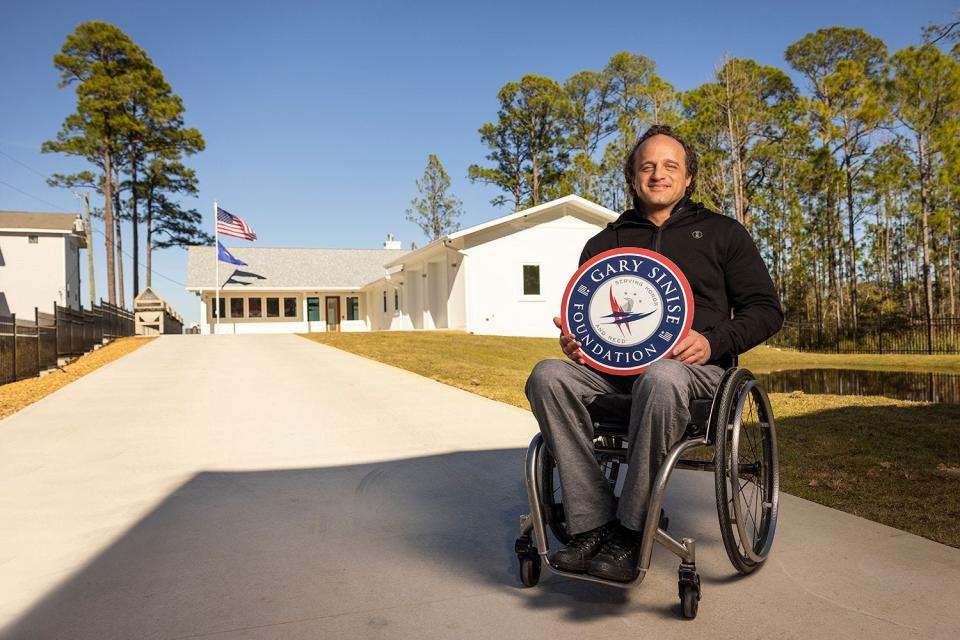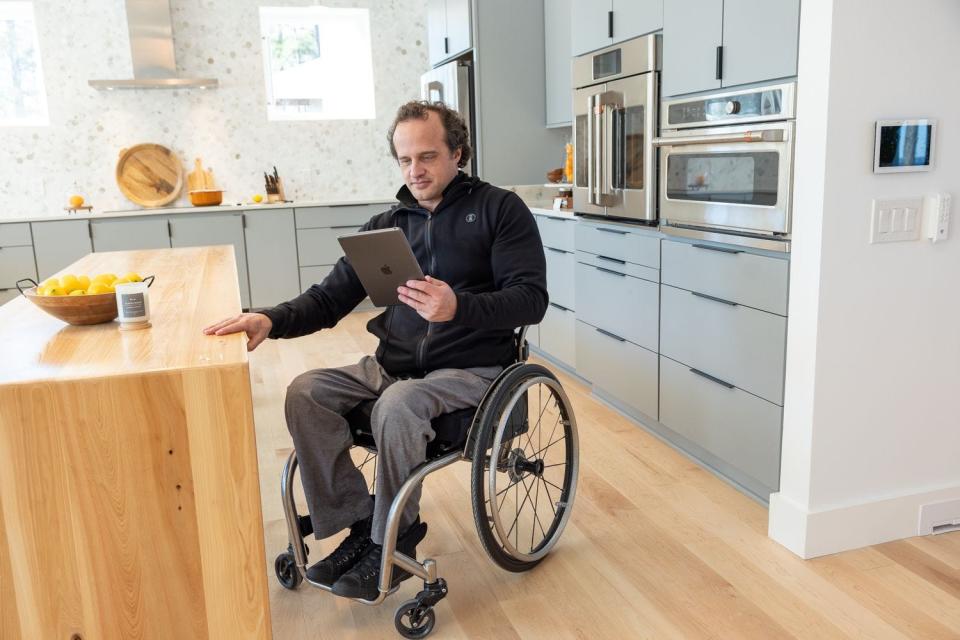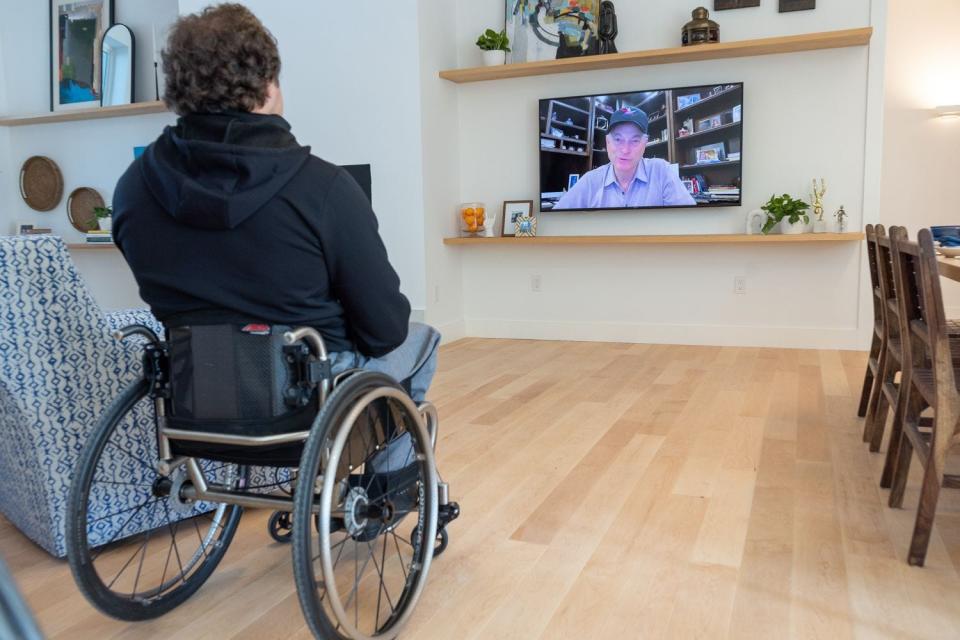'Forever home': Santa Rosa Beach wounded warrior gets house from Gary Sinise Foundation
SANTA ROSA BEACH — Now-retired Air Force Staff Sgt. Brian Schiefer wasn't supposed to be alive Wednesday. He was, in fact, supposed to have died more than a decade earlier.
Instead, Wednesday was the day Schiefer accepted the keys to his new Santa Rosa Beach home from the Gary Sinise Foundation, whose R.I.S.E. (Restoring Independence Supporting Empowerment) program provides specially adapted smart homes at no cost to the nation's most severely wounded heroes.
Sinise, an actor and humanitarian who became interested in veterans' issues after seeing how the Vietnam War affected the soldiers who fought it, established his foundation in 2011 after having worked individually to address veterans' issues. Today, the foundation operates a number of programs, in addition to R.I.S.E., to meet needs of veterans, active-duty military personnel and first responders.

Correa visit: Injured racing driver Juan Manuel Correa visits 7th Group wounded warriors to share perspectives
Service dog graduation: Veterans suffering from trauma get 'new leash on life' with K-9s at Healing Paws graduation
Fourteen years before he walked into his new house, Schiefer, then an Air Force TACP (Tactical Air Control Party Specialist, an intensely trained airman who embeds with ground units in frontline combat, with the ability to call in air strikes to assist those ground troops) was in training in the California desert for a fourth deployment overseas when a vehicle he was in overturned.
The Humvee rolled 75 feet downhill, fracturing Schiefer's spine in eight places and leaving him with a host of other injuries.
En route by helicopter to Loma Linda University Medical Center, rescuers began efforts to contact Schiefer's family for a possible last opportunity to see him.
"They didn't expect me to live through the night," Schiefer recalled Wednesday. "I was lucky to be alive, on many counts."
Schiefer underwent a 16-hour surgery, spent six weeks in intensive care, five weeks in inpatient treatment, and had five months of outpatient treatment before he was medically retired from the Air Force in 2009.
He moved to Florida the next year in hopes that the warm climate would help with one of the ongoing effects of his injury: difficulty in regulating his body temperature. During his time in the Air Force, Schiefer had spent time at Hurlburt Field, so he knew the area and saw it as a place to continue whatever healing he might find.
"I just started figuring out my life again," he said.

While taking advantage of locally available hyperbaric oxygen treatment, involving breathing pure oxygen in a pressurized environment, he also worked on everyday tasks such as reaching top shelves in stores to driving.
Additionally, Schiefer had some Air Force friends who were still at Hurlburt who assisted him in his recovery efforts.
A self-described "independent lone wolf" before his 2008 injury, Schiefer said his ongoing struggles both then and now have taught him that "it takes a community to really raise somebody."
As part of that effort, particularly in connection with his struggles related with regulating his body temperature and that he spent a lot of time indoors, Schiefer came to the realization that "the one thing I can change in this world is my environment."
He applied to the R.I.S.E. program, and following a 2018 conversation with Sinise, got on the construction list in 2020. Thus began a series of consultations between Schiefer and R.I.S.E., as happens with all R.I.S.E. homes, to tailor the home specifically to his needs.

The ongoing COVID-19 pandemic and supply chain issues imposed some delays on construction of the house, but all of that fell away as Schiefer officially took possession of the finished product Wednesday.
"I finally got to go through it last night," he said, pronouncing it "wonderful" to finally be moving into the house.
The house includes a number of features expected in a house designed for a veteran with disabilities, including a kitchen island and a cooktop lowered to wheelchair height, wide hallways to accommodate a wheelchair, and extra space in the garage to make it easier to maneuver a wheelchair up to and into a vehicle.
Beyond that, though, Schiefer's home features a guest room that is accessible for people with handicaps to accommodate friends who also are struggling with their own issues when they visit him, he said.
Additionally, in light of Schiefer's problems with body temperature regulation, the house features a number of separate zones that allow for pinpoint regulation of the house climate to ensure that he and others remain comfortable.
And because Schiefer, who now is part of a military-related consulting company started by him and some friends, spends a lot of time indoors, the house was designed to maximize the infiltration of as much daylight as possible.
Northwest Florida: 'How do I make God look good?': Special Forces master sergeant awarded Purple Heart after amputation
Everything from the orientation of the house on its lot to its windows and exterior overhangs is designed to bring light into the house. Getting to that result required significant computer modeling to determine how sunlight interacted with the structure and its lot, Schiefer said.
Overall, he said the house "will allow me to have peace of mind on a daily basis."
"There's not always going to be somebody there to assist you," he said.
Even as he is a beneficiary of the R.I.S.E. program, Schiefer also is working to help veterans. He works with Congressionally Directed Medical Research Programs (CDMRP), a U.S. Department of Defense initiative first funded by Congress in 1992 "to foster novel approaches to biomedical research in response to the expressed needs of its stakeholders — the American public, the military and Congress," according to the CDMRP website.
Schiefer, calling it "the least I can do," said he sees that work as an opportunity to be an advocate for other wounded warriors, something for which his extensive medical treatments have given him a unique and deep set of qualifications. In fact, Schiefer said his work with CDMRP has prompted other people in the organization to ask, "Are you ... going to medical school?"
Mike Thirtle, CEO of the Gary Sinise Foundation, said Wednesday that the R.I.S.E. program strives to ensure that the homes it builds are tailored specifically to the needs of the veteran who will be living in it and to the needs of family members as well.
"We look at every home differently," Thirtle said, to "try to create what Gary calls 'a forever home.'"
Schiefer's home is the 76th residence presented by the R.I.S.E. program, Thirtle said, In each case, the process occurs "over many, many, many months," including guided discussions with the eventual recipients and their families to ensure that the home will meet their needs.
"We typically support the most severely wounded veterans," Thirtle said, a process that includes having the veteran demonstrate how they are able to maneuver and what accommodations they might need.
During construction, "We'll literally take them into the home, and have them describe to us what would make their life better," he said.
Over the course of building dozens of homes, the R.I.S.E. program has been able to "develop an understanding of what people may need," and can include features in a home even if the recipient might be too proud to ask for some specific accommodation, Thirtle added.
He also noted that the Gary Sinise Foundation offers an array of help to veterans and first responders beyond mortgage-free homes. Programs range from providing the families of fallen heroes with a weeklong trip to Disney World, to referring veterans and first responders to other programs that can help with issues with which they might be struggling and buying equipment for emergency response agencies.
"We really touch right into the heart of communities," Thirtle said as he took a moment to thank donors to the foundation and its program.
"We are very grateful," Thirtle said. "We really want to care for people ... ."
This article originally appeared on Northwest Florida Daily News: Gary Sinise Foundation give home to Santa Rosa Beach wounded warrior

